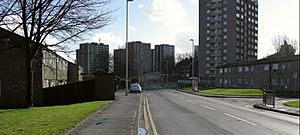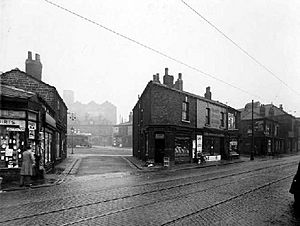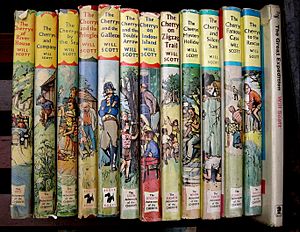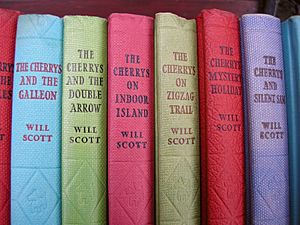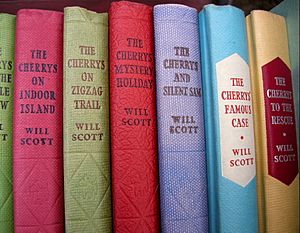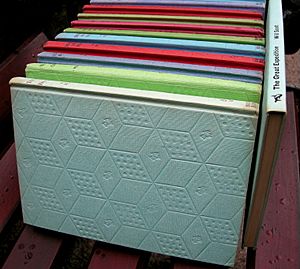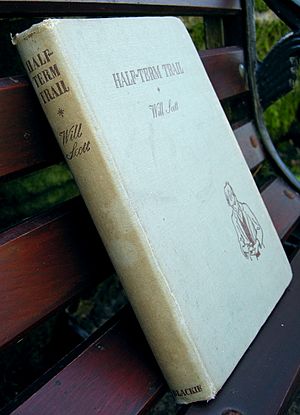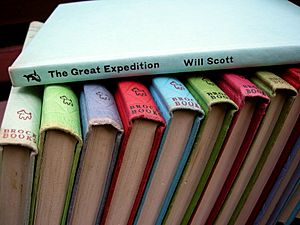William Matthew Scott facts for kids
Quick facts for kids
William Matthew Scott
|
|
|---|---|

Will Scott, 1925
|
|
| Born | William Matthew Scott 30 September 1893 Leeds, Yorkshire |
| Died | 7 May 1964 (age 70) Herne Bay, Kent |
| Pen name | Will Scott |
| Occupation | Novelist, short story writer, playwright, children's writer |
| Nationality | British |
| Period | 1920–1964 |
| Genre | Detective, thriller, mystery, children's, short story |
| Notable works | The Cherrys series, Disher Detective, The Limping Man |
William Matthew Scott (born September 30, 1893 – died May 7, 1964), known as Will Scott, was a British writer. He wrote many stories and books for both grown-ups and children from 1920 to 1965.
Later in his life, he became famous for The Cherrys series. These books were written for children and published between 1952 and 1965. Before that, he was known for his detective novels and plays. Some of his plays were even made into films, like The Limping Man. He also wrote about 2,000 short stories for magazines and newspapers. This was thought to be a record in the United Kingdom during his lifetime! As of 2011, his books are no longer being printed.
Contents
- About Will Scott's Life
- The Cherrys Series: Adventures for Kids
- First Book: The Cherrys of River House (1952)
- Second Book: The Cherrys and Company (1953)
- Third Book: The Cherrys by the Sea (1954)
- Fourth Book: The Cherrys and the Pringles (1955)
- Fifth Book: The Cherrys and the Galleon (1956)
- Sixth Book: The Cherrys and the Double Arrow (1957)
- Seventh Book: The Cherrys on Indoor Island (1958)
- Eighth Book: The Cherrys on Zigzag Trail (1959)
- Ninth Book: The Cherrys’ Mystery Holiday (1960)
- Tenth Book: The Cherrys and Silent Sam (1961)
- Eleventh Book: The Cherrys’ Famous Case (1962)
- Twelfth Book: The Cherrys to the Rescue (1963)
- Thirteenth Book: The Cherrys in the Snow (1964)
- Fourteenth Book: The Cherrys and the Blue Balloon (1965)
- Other Children's Books by Will Scott
About Will Scott's Life
His Early Years
William Matthew Scott was born in Leeds, Yorkshire, England, on September 30, 1893. His home was on Camp Road, which is now called Oatland Lane. This area was close to a neighborhood where many tailors and shoemakers lived.
When Scott was growing up, he lived in working-class areas of Leeds. These neighborhoods were close to a stream called Meanwood Beck. In those days, many houses were "back-to-backs," meaning they shared a back wall with another house. They often had shared outdoor toilets.
His father, William Scott, was a joiner (someone who builds things with wood). His mother, Eliza Anne Scott, was a tailoress. In 1893, his parents took over a tobacco shop where Will Scott was born.
By 1901, when Will Scott was seven, his family lived near a leather factory. This factory might have smelled bad, especially on windy days. In 1911, at age 17, he was learning to be a lithographic artist, which is someone who creates images for printing. He lived with his parents in a larger corner house. Many of the streets where he lived as a child were later rebuilt in the 1960s.
The Cherrys Series: Adventures for Kids
The Cherrys series has 14 books in total. They were published from 1952 until 1965, with the last book coming out after Will Scott passed away. Lilian Buchanan, who also drew pictures for some of Enid Blyton's books, illustrated the first 12 books.
These books often included maps of the made-up places where the stories happened, like Market Cray. The stories are full of black and white drawings. They are about a middle-class family with four children: Jimmy, Jane, Roy, and Pam. Their parents, especially their dad, Captain Cherry, love to play with them and encourage them to have adventures. Some of these adventures are even imaginary!
The books were written for children around 10 years old in the 1950s and 1960s. Many stories take place in the fictional village of Market Cray. Captain Cherry, the dad, is a retired explorer.
First Book: The Cherrys of River House (1952)
This book is dedicated to someone named Mike, reminding him of fun times. The story is about the children's "happenings," which is what they called their adventures. This might be one of the first times the word "happening" was used in this way.
This book was even translated into French in 1962!
Adventures in The Cherrys of River House
- First happening: They go orienteering (finding their way with a map) in a setting like East Blean Woods in Kent.
- Through hostile territory: They escape by hiding, set in fictional St Mary Cray.
- Treasure Island: They camp out in a tree, also in St Mary Cray.
- If only we’re in time!: A car rally quiz, set in a fictional bay like Minnis Bay. This is the first "Black Jack" story.
- Nothing at all to do: They send messages using animals in St Mary Cray.
- Find me who can!: The first search for Black Jack, with dares.
- He must be somebody: The second search for Black Jack, where they keep watch.
- Black Jack strikes again!: The third search for Black Jack, involving a treasure map.
- Clue upon clue: The fourth search for Black Jack, using fingerprints.
- Unmasked!: The final part of the Black Jack story, where they use disguises.
Second Book: The Cherrys and Company (1953)
This book was so popular it was reprinted four times! The cover says, "The Cherrys are a lively, likeable family." It mentions that Captain Cherry, the dad, "is constantly inventing 'Happenings' which keep the family on the move." This book was also translated into French.
Adventures in The Cherrys and Company
- The games they get up to: They play a "left-right" game in fictional St Mary Cray.
- Man in armour: A description of a big storm, possibly inspired by the North Sea flood of 1953.
- Adventure on See-Saw Mountain: They have a polar expedition in St Mary Cray.
- Disappearing trick: The first "Black Jack Junior" story, where they set false trails.
- Black Jack Junior, Pirate: The second "Black Jack Junior" story, with a boat chase.
- Kidnapped: A pirate adventure in St Mary Cray.
- Mystery of See-Saw Mountain: They go mountain-climbing.
- The Empty House: They search at night.
- Little clue, big clue: They identify an intruder.
- Biggest clue of all: A blindfolded mystery tour.
Third Book: The Cherrys by the Sea (1954)
All the adventures in this book happen at a fictional place called St Denis Bay, which is like Minnis Bay near where Will Scott lived. The map in the book, possibly drawn by Scott himself, looks similar to Minnis Bay. The stories start with a message in a bottle and end with a haunted seafront. This book was translated into French and Portuguese.
Adventures in The Cherrys by the Sea
- The message in the bottle: They find a mysterious message.
- The watch on the coast: They act as coastguards.
- On the trail of the Oozlum: They search for a wanted man.
- Alone on a desert isle: A shipwreck and rescue story.
- Follow my leader: How the Cherrys meet the Pringles, inspired by the Winnie-the-Pooh "Woozle" story.
- Look out for Smiths!: They try to avoid imaginary "Smiths."
- The slap-dash carnival: Probably inspired by the Herne Bay Carnival, with some tricky characters.
- This way or that?: They solve a secret code.
- Seaside Christmas: The children raise money to buy their own boat, the Sandman.
- The haunted sea front: They follow false clues.
Fourth Book: The Cherrys and the Pringles (1955)
In this book, the Cherry children team up with their new friends, the Pringle children. Captain Cherry creates new adventures for them. All these stories are set in fictional St Mary Cray.
Adventures in The Cherrys and the Pringles
- The great reception: The children plan a greeting committee.
- Let it rain!: They play a snakes and ladders game on the stairs.
- Mr. Pringle has a go: Mr. Pringle tries to create an adventure.
- The Crocotosh: The children hide under a raincoat.
- Early birds: They follow a trail from a newspaper.
- The other house: The first "Littles and Bigs" story, where children leave clues for adults.
- The torn treasure chart: Both groups get parts of a treasure map and must find the rest.
- The battle Of Bigs And Littles: They sneak up on each other to see the map pieces.
- Let them have it!: Roy gives the "Littles'" map pieces to the "Bigs."
- I know where!: The race to find the buried treasure.
Fifth Book: The Cherrys and the Galleon (1956)
In this story, an island becomes a make-believe galleon (a type of old sailing ship). The book includes a map of the island.
Adventures in The Cherrys and the Galleon
- The get-on-with-its
- The great cross-over
- The well-I-never place
- The seaside at home
- The peculiar periscope
- The famous think
- The big idea
- The big mystery
- The big work
- The big day
Sixth Book: The Cherrys and the Double Arrow (1957)
This story begins with Captain Cherry asking the children to find an elm tree in a wood. This was written before a disease caused most elm trees in the UK to disappear. This book was reprinted several times and translated into French.
Adventures in The Cherrys and the Double Arrow
- This way to anywhere
- The double arrow
- Adventures of Jimmy's party
- Adventures of Joe's party
- Again and again
- Roy in his own
- Public notice
- After him!
- Strange disappearance of Mr Wilks
- This way to the Bang Kwit
Seventh Book: The Cherrys on Indoor Island (1958)
This is a classic Cherrys adventure! On a rainy day, Captain Cherry turns the inside of River House into an imaginary island for the children.
Adventures in The Cherrys on Indoor Island
- The wreck
- The castaways
- The cave
- Exploring the jungle
- Mountain rescue
- The mysterious footprint
- Yes, it's pirates!
- A sail! A sail!
- But where can it be?
- Buried treasure
Eighth Book: The Cherrys on Zigzag Trail (1959)
This book was reprinted twice. The story starts with a game called Silly Golf, which might have been inspired by the crazy golf courses near Will Scott's home.
Adventures in The Cherrys on Zigzag Trail
- Mr Wilks cries ‘Look!’
- Mr. Nobody
- Nothing but mysteries
- The standstill race
- The Society For Finding Things Out
- Old sailor from over the water
- Away they go
- Smart work
- The same-sounding words
- The end if the trail
Ninth Book: The Cherrys’ Mystery Holiday (1960)
This book's title might have been inspired by "mystery tours" that bus companies offered at the time. People would pay for a day trip without knowing where they were going!
Adventures in The Cherrys’ Mystery Holiday
- Keep your eyes open
- The mystery of Mr Wotherspoon
- The mystery of the pirate chief
- Spik no English!
- The great seaweed mystery
- The writing in the sand
- The mystery of the Jumping Jacks
- The mystery of Neptune Island
- Most mysterious of all
- It's a mystery!
Tenth Book: The Cherrys and Silent Sam (1961)
This story is based on a mystery about a secret person.
Adventures in The Cherrys and Silent Sam
- A very peculiar affair
- He must be watched
- Red hot news!
- The next move
- At it again
- Caught!
- What a surprise!
- Then who is it?
- I know who it is
- Oh no, it isn't!
Eleventh Book: The Cherrys’ Famous Case (1962)
This book was published in English and another language. The story begins by exploring what clues and evidence are.
Adventures in The Cherrys’ Famous Case
- The day that woke up
- Missing!
- The Home-made Police-Force
- Hot on the trail
- The footprint again
- The light in the window
- That third clue
- Clue all the time
- Action!
- Portrait of the Queen
Twelfth Book: The Cherrys to the Rescue (1963)
This book was published in 1963 and reprinted in 1970. It's a story about a tracking game where they follow someone. The map in the book might remind you of the "Woozle" story from Winnie-the-Pooh, where Pooh and Piglet follow their own footprints!
Adventures in The Cherrys to the Rescue
- Where has he got to?
- To the rescue!
- Strange tale from a stranger
- Which way now?
- Here's your jungle!
- Escape!
- False trail
- All meet at One-Tree Hill
- Lost in the fog
- Rescue!
Thirteenth Book: The Cherrys in the Snow (1964)
This book was published in 1964 and reprinted in 1970. It might have been inspired by the very snowy winter of 1962–1963. During that winter, there was a lot of snow, and the sea even froze near Scott's house!
Adventures in The Cherrys in the Snow
- Nothing but nothing
- Enter Mr. Misery
- The start of a rumour
- The search from end to end
- You'd never guess!
- "Keep him out of sight!"
- Tell-tale trail
- If only it works
- Vanished!
- Away again
Fourteenth Book: The Cherrys and the Blue Balloon (1965)
This book was published after Will Scott passed away. The last chapter is called "Last appearance," which might be a special message.
Adventures in The Cherrys and the Blue Balloon
- First appearance of the blue balloon
- What the littles thought
- What the bigs thought
- But what did the man think?
- Watched
- Where is Augustus?
- The amazing truth
- The light in the window
- The night watch
- Last appearance of the blue balloon
Other Children's Books by Will Scott
Half-Term Trail (1955)
This book has illustrations by Mary Willett. The story takes place in a real area of Kent, but with made-up names. For example, Herne Bay is called Sandilands, and Hampton-on-Sea is called West Bay.
The story mentions famous landmarks like Herne Bay's clock tower and Hampton-on-Sea's jetty and boating lake, just as they were in 1955. The drawings inside the book don't look exactly like these places, but a map at the end, possibly drawn by Will Scott, clearly shows the real area.
Chapters in Half-Term Trail
- The Very Beginning
- The Tuckers and the Tanners
- Mystery!
- And More Mystery!
- The Knife
- First Clue to Tim
- Rings Round Dilly Dally
- Surprises
- Sticky's Story
- The Chase Begins
- Big Clue to Mary
- The Trail of the Chalk Crosses
- Tim Alone
- Only One Missing
- "I've got it!"
- The Case is closed
- Map of West Bay, Sandilands
The Great Expedition (1962)
Will Scott originally wanted this to be the thirteenth book in The Cherrys series. However, his agent thought that having a "thirteenth" book for children might not be a good idea. So, it was published as a separate book.
The book has many colorful and black-and-white pictures by C. Clixby Watson, and maps by Henry West. The book cover says that an old night-watchman taught three boys, Dick, Mick, and Henry, that any place they hadn't visited was "uncharted territory." This meant they didn't need to climb Mount Everest to have an exciting adventure! They found that tracing an unnamed river to its source was a thrilling journey. The story is set near Newbury, Berkshire.
Chapters in The Great Expedition
- Somewhere – But Where?
- The End of Somewhere
- The Beginning of Nowhere
- Several Questions
- The Second Camp
- The Relief Expedition
- The Rising at Million Bridges
- The Expedition Moves On
- The Last Camp
- Green Hat's Game
- No Time to Lose
- The Last Lap
- The Top of All
- Back to Somewhere


